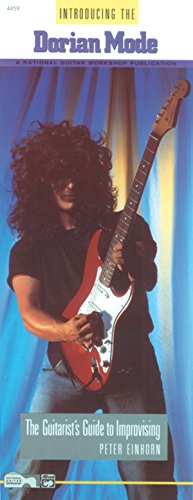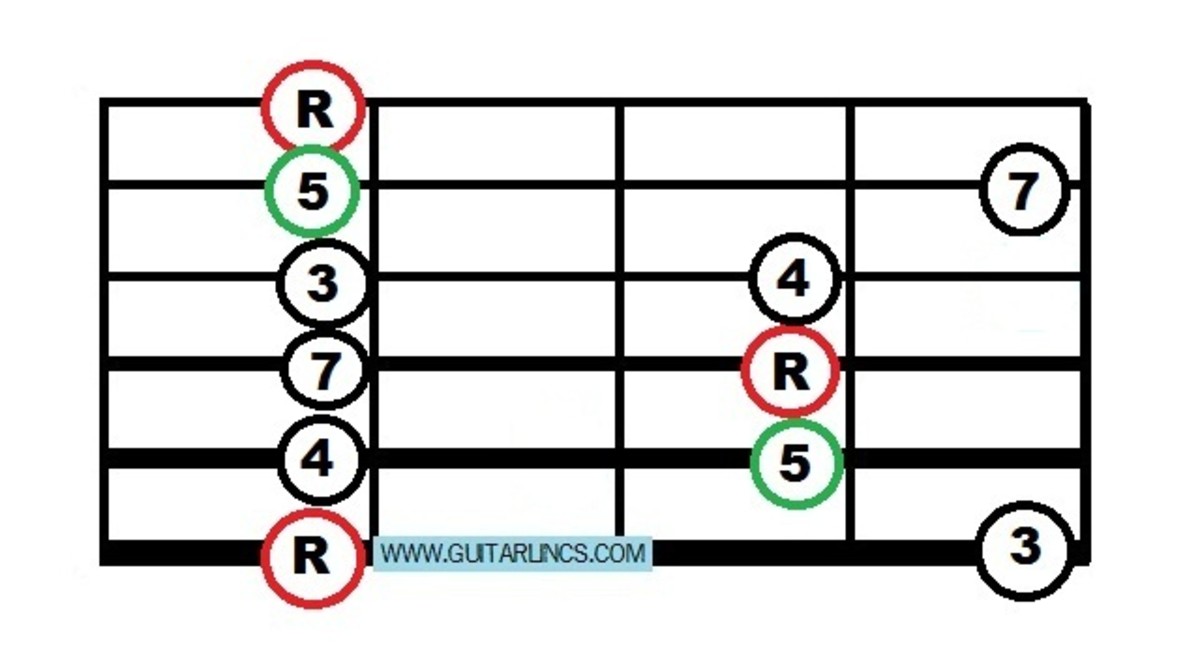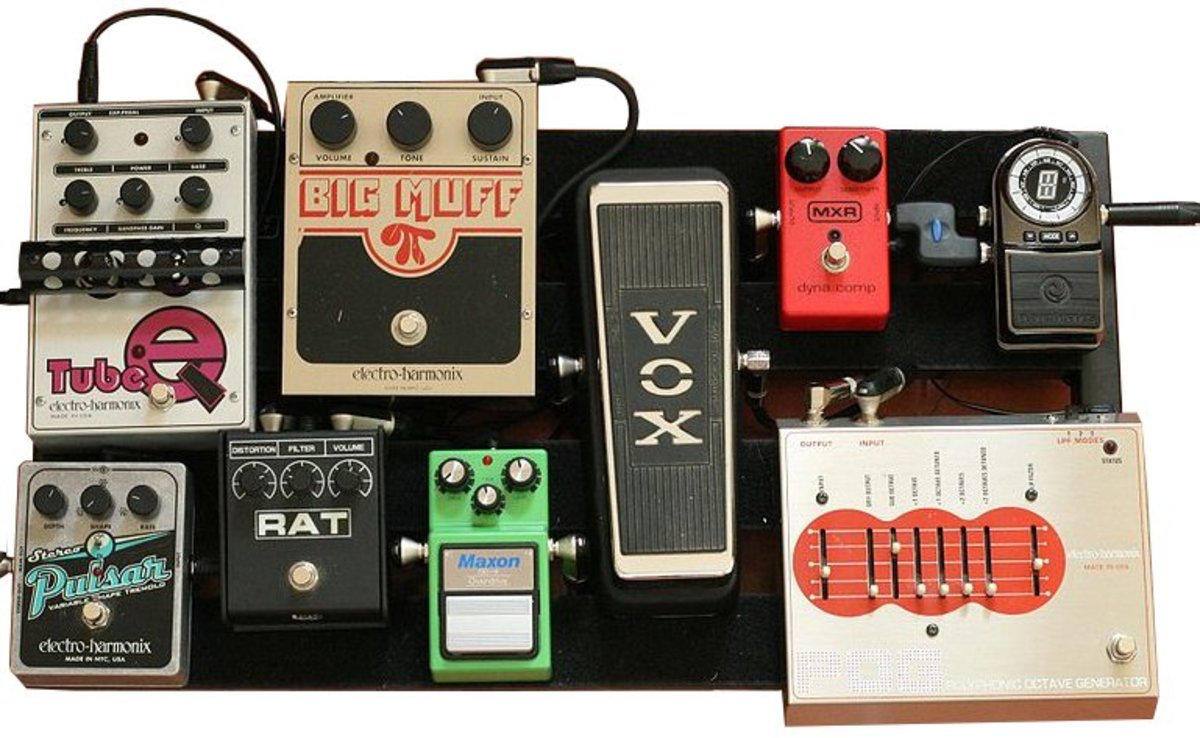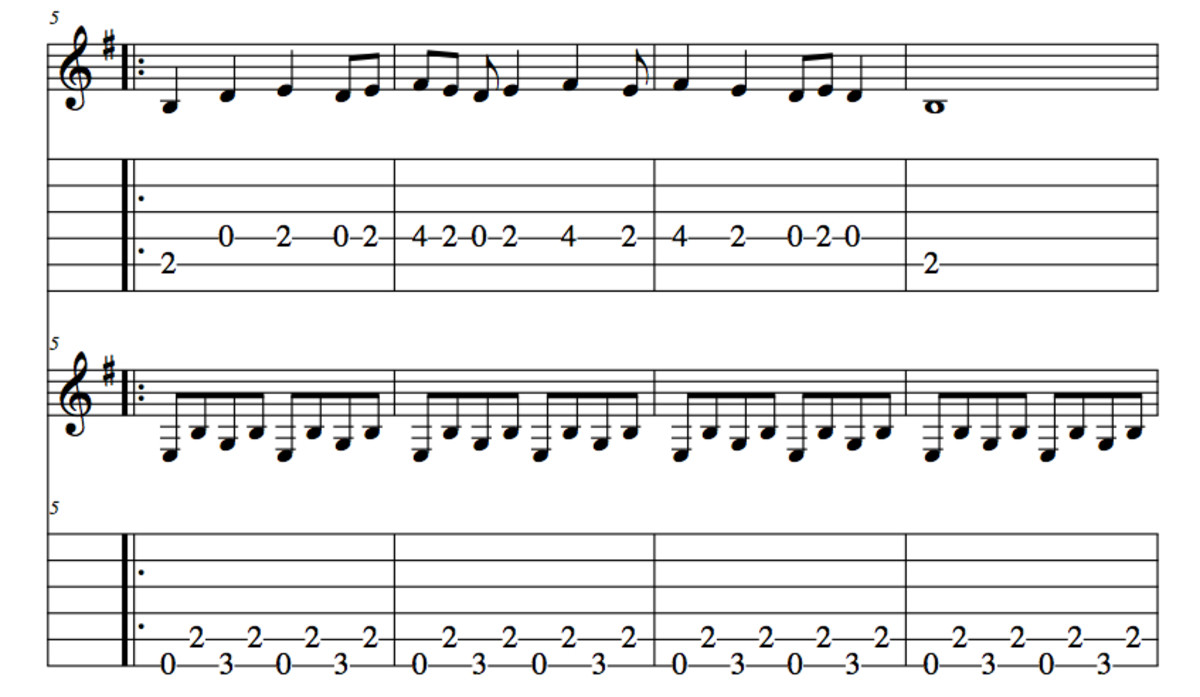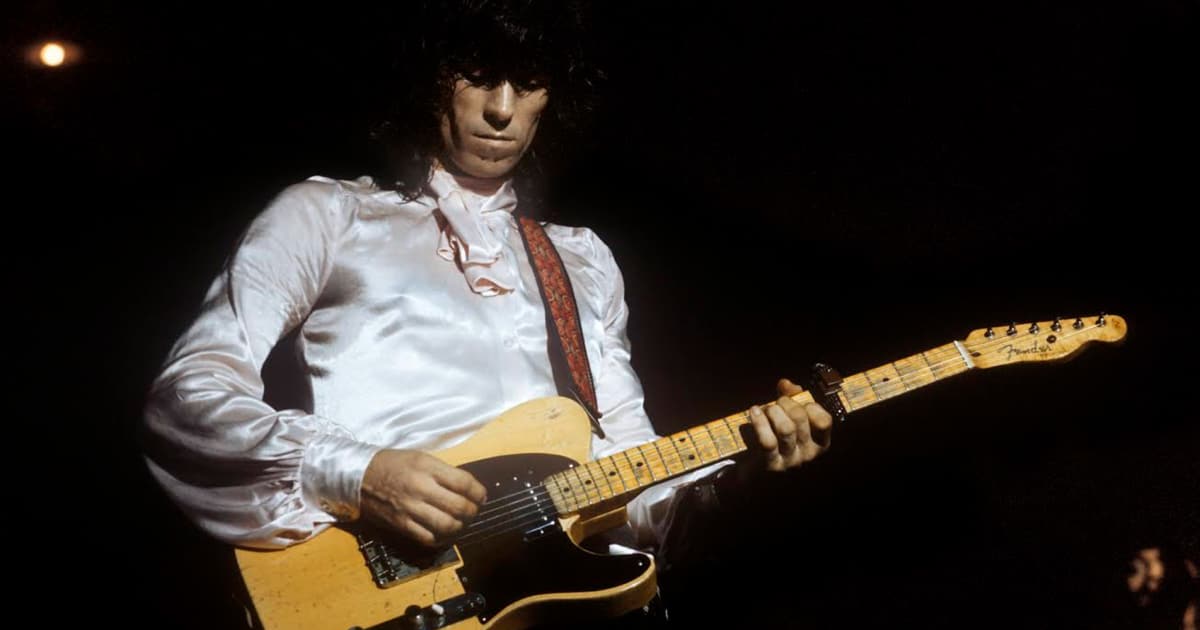How to Improvise on Guitar with The Dorian Mode
What is the Dorian Mode?
The Dorian mode is often explained as "simply the white notes on the piano starting on D". As a young guitarist and composer I found the approach of relating modes to the C major scale, although theoretically correct, was no help whatsoever. To be comfortable as a composer with the Dorian, you need to understand all its key variations and its basic harmony, you have to transpose the characteristic intervals in your head. This takes time. As a guitar player you don't need to do this to enjoy its versatility and interesting sound. To be comfortable as a guitarist you only need to relate it to fretboard shapes you already know. The best shape to attach it to is in fact the minor pentatonic. This page will show you how to do this and become confident soloing with the Dorian mode.
The Minor Pentatonic Box
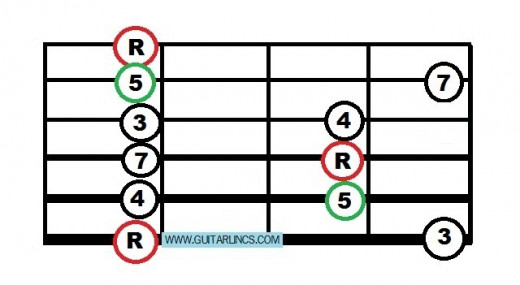
What do you need for this lesson on the Dorian mode?
- A little experience as a guitar player.
- The drive to learn to improvise rather than just copy other solos.
- A practical knowledge of pentatonic scales and positions.
- Something to listen to music on.
- A guitar and the will to succeed with new things.
The most important thing is to be able to use the pentatonic scale so if you haven't already done so, I suggest you check out my pages on improvising in the pentatonic box and extending the pentatonic scale. Without that familiarity, it will be more difficult (though not impossible) to pick up this lesson on how to solo in the Dorian mode.
For a sound basis in Dorian improvisation...
If you are less experienced with pentatonic improvisation, check out these lessons on how to improvise in the pentatonic box and how to extend the pentatonic scale over the fretboard.
Preparation that might be helpful for this lesson
- How to Improvise in the Pentatonic Box
What is the pentatonic box and how do you use it? The pentatonic box is an almost foolproof way to improvise lead guitar. This page shows how to improvise in the pentatonic box on guitar. - How to Improvise on the Guitar - Extending Pentatonics out of the Box
The pentatonic scale is a gift to musicians learning to improvise and the pentatonic box is one of the first things guitarists learn but getting out of the pentatonic box makes solos more interesting.
A Minor Pentatonic to A Dorian
Starting with A minor pentatonic is probably best as it is a common key in rock music and fits the five shape model quite easily. Many guitarists start their lead guitar improvising with the "blues box" in the fifth position so it should be familiar to you either as A blues or A minor pentatonic. There is only one note difference between the two. Beginners can use open chord shapes for the harmonies too.
The notes in A minor pentatonic are:
A , C, D , E , G
The notes of A dorian are:
A , B , C , D , E , F# , G
You can see there are two notes added to make the Dorian mode, those notes are B and F# and will give a clue to Dorian harmony.
A typical chord progression for A minor pentatonic improvisation would be:
Am / / / Em / / / Am / / / C / / / Dm / / / Am / / / Em / / / Am / / /
Something more suggestive of the Dorian mode might be:
Am / / / D / / / Am / / / G / / / D / / / Bm / / / Em / / / Am / / /
We can use D and Bm because of that F#. or raised 6th. That note is characteristic of the Dorian mode and gives it a personality that is equally at home in folk, hard rock and even jazz.
I want to keep the theory simple for this lesson because the emphasis is on making it easy, but I think understanding what the special note is means we can use that note to convey the Dorian sound.
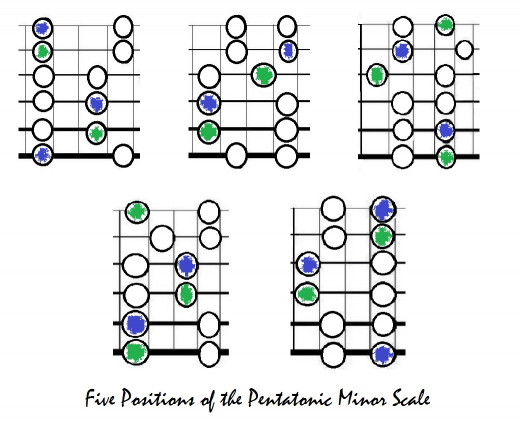
Five positions of the Dorian Mode superimposed on the Pentatonic
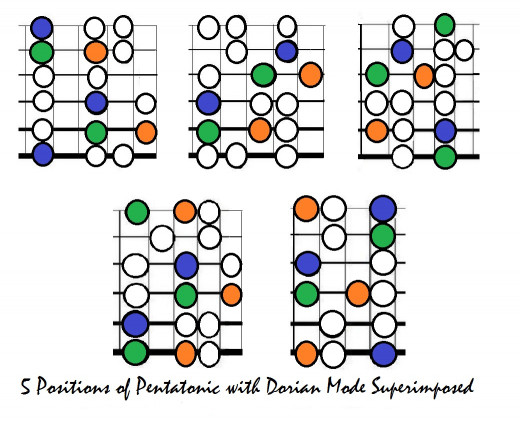
Learning to solo in the Dorian Mode.
Assuming you are familiar with the pentatonic box then first look at the diagram on the top row, first on the left. If you compare that with the image of the pentatonic box in the chart above it you will see it has more notes added. Technically speaking, these notes are the second and the sixth of the minor scale, the sixth is raised by a semitone using the sharp sign #
In pentatonic scales there are five different notes and in regular scales there are seven. That is why modes have more variety and character. The reason I relate the Dorian mode to the pentatonic is that it is much easier for beginners to cope with than relating it to the major scale as textbooks do. Trust me, it works and we can handle complicated theory later. This is what I want you to do:
- Strum an A minor chord, then make up a short musical phrase that starts on a blue note and uses close notes.
- Do the same, but take your phrase to the nearest orange note and back again.
- Explore the first pattern thoroughly in short 5, 6 or 7 note phrases. Try to avoid too much "jumping" around the box but keep the phrases close so you could easily hum along with them. Try to avoid just playing the scale by moving back and forth from the blue note.
- Do the same thing using the green and orange notes as your focus and Em as your starter chord.
- Record or play a vamp of Am and D chords (or get a friend to do it) then enjoy yourself making up a few licks over the vamp.
If you can set up a loop with digital delay pedal, then do so and practice the above with each of the following chords: Am, Bm, C, D, Em, F#dim, G
What we are doing with all this is just getting familiar with the notes you can use and the sounds of the Dorian scale. The not so technical term guitarists for this is noodling.
To make the other Dorian mode shapes work with the chords in A minor (Dorian)
You need to know which position to play each shape. Position is determined by which fret your first finger is on or where the shape starts on the neck. Here goes for the key of A minor or A Dorian mode:
Making the shapes work for A Minor Dorian harmony
Top Row:
Left shape is fifth position
Centre shape is seventh position
Right shape is ninth position
Bottom Row:
Left shape is twelfth position
Right shape is fourteenth position
A Great Dorian Backtrack to Noodle With!
Connecting the shapes for the Dorian mode
When you really do have a feel for the A Dorian mode then it is a good idea to practice connecting these shapes. You should be happy to slide in and out of each shape by now but you will most likely have to record a chord progression, buy an appropriate backing track or ask a friend to play rhythm so you can "noodle" with the whole fretboard.
Remember these shapes are completely movable and my next lesson is going to focus on movable chords and scales.
Backing Track for A Minor Dorian

A Dorian Whole Fretboard Map
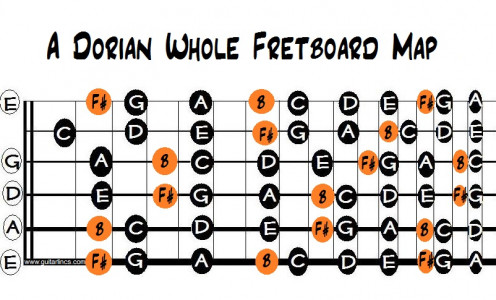
A List of Dorian Songs
Sometimes a good place to start is just to listen to a few songs that use the Dorian Mode either in the melody or in a solo. The variety is huge but here are a few that are generally acknowledged to be good listening:
- All Blues – Miles Davis (mixolydian moving to parallel dorian and back again)
- All The Pretty Little Horses
- All Through the Night
- Along Comes Mary - Association
- Another Brick In The Wall – Pink Floyd – the whole song is virtually D Dorian
- Bachelor's Hall
- Bach - Toccata and Fugue in D minor, BWV 538 (not THE Toccata and Fugue – but another one)
- Bad Horsie - Steve Vai
- Beat it! - Michael Jackson
- Be Thou My Vision - Hymn
- Billie Jean - Michael Jackson - intro and main verse vamp
- Black is the Colour of My True Love’s Hair
- Boulevard of Broken Dreams – Green Day
- Break On Through (To the Other Side) - The Doors
- Breathe - by Pink Floyd (the first part of the intro and verse are in E Dorian over and Em-A7 chord vamp.
- Brush with the Blues - Jeff Beck
- Cindy, Cindy
- City of New Orleans - Arlo Guthrie
- Clinch Mountain Backstep
- Cluck Old Hen
- Cool #9 - Joe Satriani (which is full of great sounding Dorian licks)
- Cripple Creek
- Dear Companion
- Dear Old Stockholm - Miles Davis
- Drowsy Maggie
- Drunken Sailor
- Eleanor Rigby – The Beatles
- Et incarnatus est - Credo movement from Missa Solemnis by Beethoven
- Evil Ways – Santana
- Get Lucky - Daft Punk
- Great Gig in the Sky – Pink Floyd (the final section is in G dorian)
- Hey Ho Nobody Home - Round
- Horse With No Name – America
- Hughie the Graeme
- In the Pines
- Knockin' on Heaven's Door – Bob Dylan
- Light My Fire – The Doors – solo section has groove in A dorian over a Am7-Bm7 vamp.
- Little Sadie
- Long Train Running by The Doobie Brothers
- Maiden Voyage - Herbie Hancock Dorian and A Aeolian
- Milestones - Miles Davis,
- Moondance – Van Morrison – mostly dorian except for the prechorus which is minor
- My Little Welsh Home
- Night The Lights Went Out In Georgia - Vicki Lawrence/Bobby Russell
- Norwegian Wood - mainly mixolydian but moves to dorian over middle eight
- Nottamun Town
- Over the River Charlie
- Oye Como Va - Carlos Santana
- Paradise - Coldplay,
- Pretty Polly
- Purple Haze - Jimi Hendrix - solo: E dorian
- Riders on the Storm – The Doors
- Sailor's Song
- Scarborough Fair by Simon and Garfunkel
- Shady Grove
- She's Not There - Zombies mostly A dorian (Am-D7), but with some A minor key chords (F, Dm, E).
- Shine on you Crazy Diamond – Pink Floyd second part of intro riff over Gm-C = G dorian
- Smoke on the Water - Deep Purple
- Sovay
- So What – Miles Davis - the tonality changes between D Dorian and Eb Dorian over AABA form (A sections D Dorian and B section is Eb Dorian)
- Star of County Down
- Star of Munster
- Stairway To Heaven - Led Zeppelin - mainly middle section
- Surfing With The Alien – Joe Satriani
- Swallowtail Jig
- Tender Surrender by Steve Vai
- This Diamond Ring – Gary Lewis and The Playboys
- Wedding Dress (a.k.a. Little Doney Gal)
- Who Will Save Your Soul – Jewel solo
- Wicked Game – Chris Isaac
- Wondrous Love - Hymn
- Wreck of the Edmund Fitzgerald - Gordon Lightfoot
- You Know You Know - Mahavishnu Orchestra - E Dorian
Focusing on the Dorian Mode in Guitar
Are modes easy or hard?
Modes have complicated names and theory but are they easy to work with?
© 2014 Lisa Marie Gabriel

